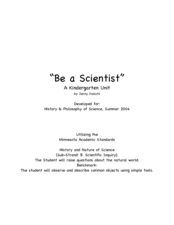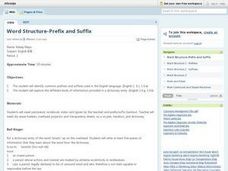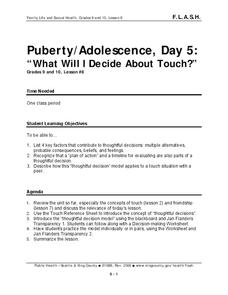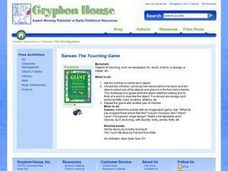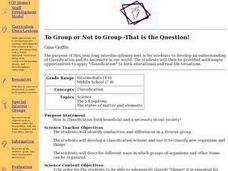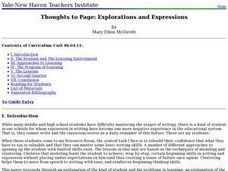Curated OER
Light, Colors, and Vision
Third graders experience optic illusions by creating flipbooks. In this optics lesson, 3rd graders view a demonstration of the workings of rods and cones using a camera. They are shown an optical illusion and work to create their own...
Curated OER
Rainbow milk
This activity explores the sense of sight, nutritional needs, and the importance of milk and dairy in our diet. Learners discuss color mixing, surface tension and rainbow milk. Students actively mix three colors of food coloring with...
Curated OER
Be a Scientist: A Kindergarten Unit
Students conduct observations using their five senses. In this science lesson, students describe different states of matter. They investigate the factors affecting mold growth.
Curated OER
The Physics of Sound: How We Produce Sounds
Young scholars are introduced to how they produce sounds. In groups, they participate in experiments in which they measure sound and identify their five senses. Individually, they make their own musical instruments using different...
Curated OER
Science Unit Lesson Five
Sixth graders review how and which plants operate in terrariums. In groups, they follow instructions to make their own terrarium and place different types of plants in it. To end the lesson, they review the steps in the water cycle and...
Curated OER
Hold Off on the Headphones
Students explore hearing loss caused by sound waves. For this physical science lesson plan, students will start by learning about waves and wave characteristics and move into sound waves. Students will study how sound effects their...
Curated OER
Sense-Ability
Students use comparisons, graphing, patterning, and sorting, and develop language skills as they explore the five senses.
Curated OER
'Me Fail English? That's Unpossible' : Studying Literature with "The Simpsons"
Does your class love The Simpsons? It might seem dated, but with reruns constantly popping up on television, this show still holds the attention of most of your learners. Play the opening sequence of an episode, and brainstorm any...
NASA
Revising an Investigation
Write, edit, and then revise! The fourth lesson in a five-part series asks peers to provide feedback on research. Individuals then use the research to edit and revise conclusions and develop their presentations.
EnLiST
Trap Your Own Insects: What’s in Your Backyard?
Young entomologists construct three types of insect traps—pitfall, pollinator, and panel—before setting their traps out and observing what they caught. They then observe what types of insects the different traps attract.
Curated OER
Word Structure- Prefix and Suffix
Identify common prefixes and suffixes used in the English language and categorize the different kinds of information provided in a dictionary entry. Learners will write at least five pieces of information that they learn about a word...
Curated OER
Puberty/Adolescence Day 5: What Will I Decide About Touch?
High schoolers follow the thoughtful decision model and decide which kind of touching is okay and which is not as a teen. In this touch lesson plan, students also learn how to communicate those decisions.
Curated OER
Meet Our Teachers
Learners of all ages interview, record, and photograph teachers and staff at their school. They organize the photo with a soundbite into a PowerPoint presentation. They transcribe the interview and write a response to it.
Curated OER
Sense of Taste and the Tongue
Students taste different foods and record their reaction to each one. They record their likes, dislikes, and favorites and create a graph. Then they use the graph to compare the tastes of the class.
LABScI
Vision Lab: The Eye
Our bodies have some amazing capabilities, but there are some limitations. Explore the limitations of the human eye through the eighth lab activity in a series of 12 biology lessons. Individuals measure their own peripheral vision...
Curated OER
Brain and Senses
Young scholars investigate the brain through multiple senses. In this biology lesson, students experiment with different activities involving taste, memory, touch, and sight to understand how the brain works. Young scholars work in...
Curated OER
The Sensitive Scavenger
Students create multi-sensory scavenger hunt worksheet to be used on a scavenger hunt throughout the schoolyard habitat area to introduce students to concepts of biodiversity and interdependence within a habitat.
Curated OER
On Your Mark, Get Set, Read!
Are your beginning readers trying to build fluency? Use this activity to teach them how to monitor their reading fluency. First they get a sentence to practice with, reading it to their partner once and rereading it silently five times....
Curated OER
Mystery of the Senses-Touch
Students test the skin's range of sensitivity. Students complete a "Touch Areas" activity. They discuss their results with the class. Students make conclusions about which parts of the body are most sensitive to touch.
Curated OER
Senses -- The Touching Game
Students practice making educated guesses about objects in their hands. They guess what the object is without looking at it and choose a word that describes it. They practice using new vocabulary as well.
Curated OER
What Food Is It?
Students close their eyes and taste foods without using the sense of sight to identify the foods. They record what they think the food is that they tasted.
Curated OER
To Group of Not to Group - That is the Question!
Upper elementary and middle schoolers use their observation skills to group different kinds of candy by similar characteristics. They debate whether or not we should classify objects. Finally, they learn that biologists have developed a...
Novelinks
Touching Spirit Bear: Anticipatory Guide
Will Peter and Cole ever forgive one another? Anticipation guides contain questions such as this to help teach readers how to make predictions about a text. First out of a series of five resources, the guide is full of statements about...
Curated OER
Thoughts to Page: Explorations and Expressions
Young scholars are introduced to the correct techniques to use for proper writing. In groups, they practice the use of clustering to help them organize their thoughts and identify the main idea of their paper. To end the lesson, they...


